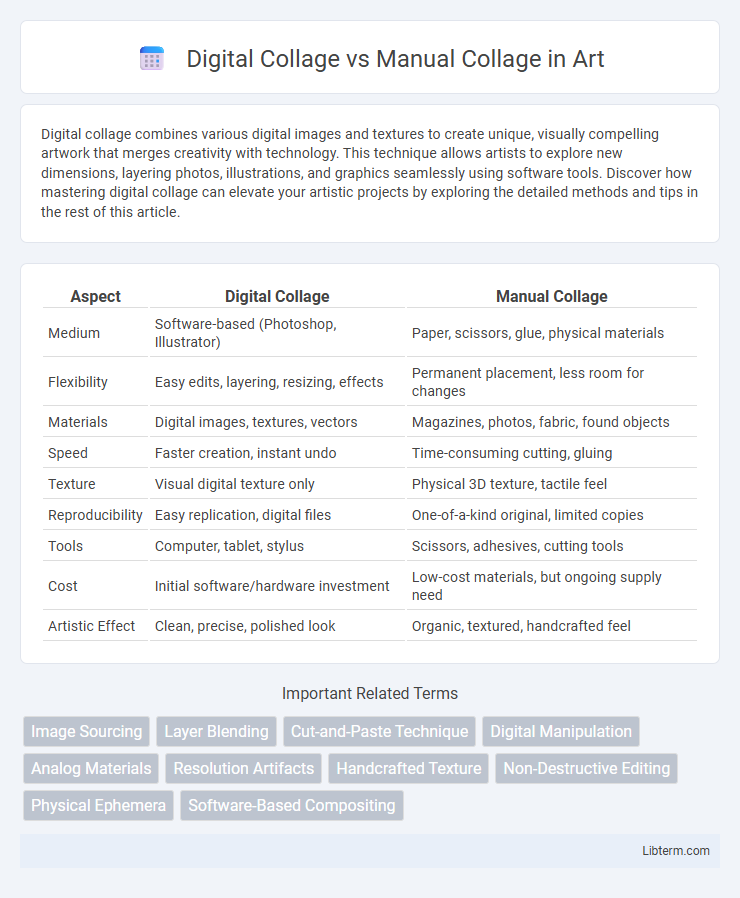Digital collage combines various digital images and textures to create unique, visually compelling artwork that merges creativity with technology. This technique allows artists to explore new dimensions, layering photos, illustrations, and graphics seamlessly using software tools. Discover how mastering digital collage can elevate your artistic projects by exploring the detailed methods and tips in the rest of this article.
Table of Comparison
| Aspect | Digital Collage | Manual Collage |
|---|---|---|
| Medium | Software-based (Photoshop, Illustrator) | Paper, scissors, glue, physical materials |
| Flexibility | Easy edits, layering, resizing, effects | Permanent placement, less room for changes |
| Materials | Digital images, textures, vectors | Magazines, photos, fabric, found objects |
| Speed | Faster creation, instant undo | Time-consuming cutting, gluing |
| Texture | Visual digital texture only | Physical 3D texture, tactile feel |
| Reproducibility | Easy replication, digital files | One-of-a-kind original, limited copies |
| Tools | Computer, tablet, stylus | Scissors, adhesives, cutting tools |
| Cost | Initial software/hardware investment | Low-cost materials, but ongoing supply need |
| Artistic Effect | Clean, precise, polished look | Organic, textured, handcrafted feel |
Understanding Digital Collage: An Overview
Digital collage utilizes software tools like Adobe Photoshop and Procreate to combine images, graphics, and textures digitally, allowing precise manipulation and layering. It offers advantages in editing flexibility, faster experimentation, and easy replication compared to manual collage, which relies on physical materials such as paper, photographs, and adhesives. Understanding digital collage involves recognizing its integration of digital media, enabling artists to create complex compositions with enhanced control and creative possibilities.
Manual Collage: The Traditional Technique
Manual collage, the traditional technique, involves physically cutting, layering, and pasting different materials such as paper, photographs, and fabric onto a surface, creating textured and tactile artworks. This hands-on approach allows artists to experiment with various textures and materials, resulting in unique, one-of-a-kind pieces that reflect personal craftsmanship. Unlike digital collage, manual collage emphasizes the physical interaction between artist and medium, enhancing the authenticity and sensory experience of the artwork.
Tools and Materials: Digital vs Manual Collage
Digital collage employs software like Adobe Photoshop, Procreate, and Canva, utilizing tools such as layers, masks, and digital brushes for precise manipulation and seamless integration of images. Manual collage relies on physical materials including magazines, scissors, glue, and textured papers, offering tactile engagement and unique surface effects. The digital approach enables easy editing and replication, whereas manual collage provides tangible creativity and one-of-a-kind textural depth.
Creative Process: Step-by-Step Comparison
Digital collage streamlines the creative process with layers, easy adjustments, and a vast array of digital tools for precise manipulation and experimentation. Manual collage involves tactile materials, requiring physical cutting, arranging, and gluing, which fosters a more hands-on, sensory experience but limits rapid revisions. Both methods engage unique workflows where digital offers efficiency and flexibility, while manual provides a tangible, organic connection to materials.
Artistic Flexibility and Limitations
Digital collage offers unparalleled artistic flexibility through tools like layers, undo functions, and unlimited color palettes, allowing artists to experiment and refine compositions effortlessly. Manual collage demands hands-on techniques with physical materials, limiting immediate edits but providing tactile texture and a unique, organic aesthetic. While digital methods enable rapid alterations and integration of diverse media, manual collages offer a distinct authenticity and materiality that digital replication often struggles to capture.
Time Investment and Workflow Efficiency
Digital collage significantly reduces time investment by streamlining the selection, editing, and layering processes with tools like Photoshop and Procreate, enabling faster adjustments and iterations. Manual collage demands considerable time for cutting, arranging, and gluing physical materials, often requiring more trial and error to achieve the desired composition. Workflow efficiency in digital collage benefits from features like undo, layering, and easy duplication, whereas manual collage's tactile approach offers creative freedom but less speed and flexibility.
Texture and Physicality in Collage Art
Digital collage offers limitless texture manipulation through software tools, enabling artists to layer, distort, and blend images with precision and ease, creating intricate visual effects unattainable in manual methods. Manual collage emphasizes tactile engagement, with physical materials like paper, fabric, and found objects contributing tangible textures and dimensionality that evoke a sensory connection and authenticity. The contrast between digital and manual collage lies in the physicality of materials, where manual work invites sensory exploration, while digital methods prioritize versatile texture simulation and virtual layering possibilities.
Editing and Revisions: Digital vs Manual Approaches
Digital collage offers unparalleled flexibility in editing and revisions, allowing artists to easily manipulate individual layers, adjust colors, and reposition elements with precision using software tools like Adobe Photoshop or Procreate. Manual collage requires physical reassembly or patching, making iterative changes time-consuming and potentially damaging to the original materials. The digital approach significantly accelerates the creative process by enabling non-destructive editing and infinite undo options, whereas manual collage demands meticulous planning and patience for each modification.
Environmental Impact of Collage Methods
Digital collage significantly reduces environmental impact by eliminating the need for physical materials such as paper, glue, and scissors, which often generate waste and consume resources. Manual collage involves cutting and assembling tangible materials, leading to paper waste, use of adhesives containing volatile organic compounds, and increased energy consumption during production and disposal. Artists opting for digital collage contribute to sustainable practices by minimizing material waste and lowering their carbon footprint through virtual manipulation tools and reusable digital assets.
Which Collage Style Suits You Best?
Digital collage offers precise editing, easy layering, and access to vast image libraries, making it ideal for tech-savvy creators seeking flexibility and speed. Manual collage provides tactile experience and unique textural qualities, perfect for artists valuing hands-on craftsmanship and organic imperfections. Choosing between digital and manual collage depends on your preference for creative control, desired aesthetic, and workflow convenience.
Digital Collage Infographic

 libterm.com
libterm.com